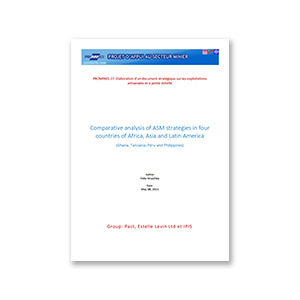Author(s): Felix Hruschka
Client(s): PROMINES
Levin Sources was commissioned to conduct this comparative analysis of artisanal and small-scale mining (ASM) strategies of four countries by PROMINES, with financing provided by the World Bank.
It was a deliverable submitted as part of a larger project “Development of a Strategic Document on ASM in DRC” in which Levin Sources, PACT and IPIS worked to develop a strategic plan and action plan for SAESSCAM, the organisation mandated with the formalisation of the ASM sector in DRC.
The objective of the comparative analysis of four countries is to find models and best practices that could inspire the formulation of the DRC’s national policy and strategy towards an ASM sector that contributes to poverty reduction through the creation of stable and dignified employment opportunities, as well as to GDP growth through an increased mineral production.
Following a rapid scoping analysis of nine countries, four countries where chosen for the analysis: Ghana, Tanzania, Peru and the Philippines.
The report draws the following conclusions:
Artisanal and Small-scale Mining (ASM) is highly relevant in all four countries. ASM miners comprise a significant percentage of the rural population in all countries, and the sector contributes importantly not only to livelihoods but also to the national GDP. However instead of being incorporated into poverty reduction strategies, the ASM sector is seeing increasing criminalisation and margnialisation by governments. This largely negative portrayal overlooks the great diversity which exists within the sector and obscures the multiple cases where ASM complies or has the intention to comply with all local legislation and best practice. Following this trend of neglect, the rising gold prices of the past decade finally allowed many artisanal operators to invest in mechanization and to up-scale their mines. Existing operations became more intensive and new actors entered, seeking quick profits. By outgrowing their category and not conforming with terms of larger scale mining according to the general mining law, some of these mines have in fact become “illegal”. With most ASM legislations dating back to the period of the 1980s to early 2000s, entire legal frameworks for ASM became outdated and virtually “collapsed” under the gold-rush of the 2000s. Under these circumstances political decision makers started to “panic”, responding with heavy-handed interdiction approaches. Chances that this approach leads to sustainable results are considered minimal. Among the four countries compared in this paper, Tanzania appears to be the only country not attempting to battle against illegal mining but focusing on improving the livelihoods and practices of small-scale miners. While Peru had similar intentions, their decision to delegate responsibilities to regional governments which did not have the adequate resources to manage the ASM sector stalled their progress. In all countries, mining authorities tend to prioritise large mining corporations who contribute with high taxation to the expense of ASM who are marginal taxpayers.
Based upon these conclusions and lessons learned from these countries, the report draws fundamental recommendations on formulating a national strategy for empowering a productive and sustainable ASM sector.



